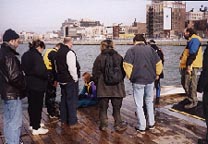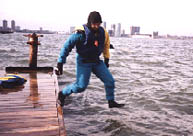

1. Amount of subcutaneus body fat — cooling rate inversely related to fat layer thickness — the most powerful determinant
2. Body size and build — relationship between body surface area and volume
- tall
skinny subjects cool faster; short, fat, build bodies cool more slowly
- children
cool faster than adults
3. Ability to shiver — vary with fatigue, hypoglycemia, health, muscle mass, alcohol and drug ingestion, age and core temperature
- shivering fails when unconsciousness occurs — fatal outcome
4. Gender differences — negligible
5. Fitness — fit individuals tolerate longer immersion time
Water temperature
1. Very important determinant — the colder the water the faster the cooling
Clothing
Insulating properties of the trapped air between the skin and the protective clothing to limit heat loss. The ticker the air layer the greater the insulation.
Types protective clothing
Normally in 50 Modifiers of cooling rate in cold water Individual determinants
1. Amount of subcutaneus body fat — cooling rate inversely related to fat layer thickness — the most powerful determinant
2. Body size and build — relationship between body surface area and volume
- tall skinny
subjects cool faster; short, fat, build bodies cool more slowly
- children cool faster than adults
3. Ability to shiver — vary with fatigue, hypoglycemia, health, muscle mass, alcohol and drug ingestion, age and core temperature
- shivering fails when unconsciousness occurs — fatal outcome
4. Gender differences — negligible
5. Fitness — fit individuals tolerate longer immersion time
Water temperature
1. Very important determinant — the colder the water the faster the cooling
Clothing
Insulating properties of the trapped air between the skin and the protective clothing to limit heat loss. The ticker the air layer the greater the insulation.

Types protective clothing
Normally in SOT water the body T falls by 80 - 40F/hr if no protective clothing is worn. 1. "Wet" suits — minimize cooling (cooling rate 4 - O.70FIbr)
- do not exclude but minimize water between skin and garment
2. "Dry" suits — significantly minimize cooling (cooling rate 1.4 — 0.3 0F/br)
- exclude
water from access beneath clothing
- use
of impermeable wrist, ankle, neck seals and water-tight zippers
Alcohol
1. Rate
of heat loss is not significantly increase
2. Rate
of heat production by shivering is slightly reduced
4. Fatigue
potentiates thermoregulatory impairment by alcohol
5. Perception
of cold is diminished — shivering
6. Cold-induced
diuresis is -- risk for hypovolemia and dehydration
7. Highly
intoxicated individuals die from drowning, not from hypothermia
Food
Usually not a significant factor, but individuals that are food-deprived for long time will cool faster due to depletion of carbohydrate reserves.
Behavior
Has a significant influence on survival and body cooling times — exercise increases cooling time 35-50% due to increased blood flow to the muscles during activity and increased water flow under the protective clothing. Holding still minimizes cooling!!!!
1. Hold still — H.E.L.P. (Heat Escape Lessening Position) position
2. Adopt
fetal position - contact surface of the body
3. Maximize
body-to-body contact with other survivors — HUDDLE position
4. Maximize
the amount of the body parts out of the water
N.B. Heat loss in cold air even in windy conditions is much less than in the water with the same temperature! !!!